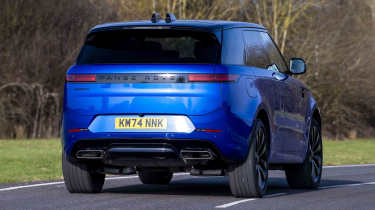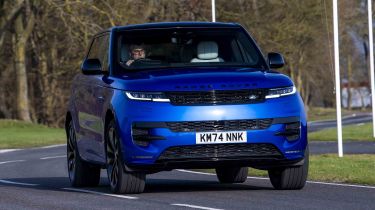Range Rover Sport - Engines, performance and drive
The Range Rover Sport features a strong line-up of petrol, diesel and plug-in hybrid engines, while refinement is greater

At 2.3 tonnes in petrol and diesel form (or nearly 2.7 tonnes as a plug-in hybrid) the Range Rover Sport is a sizeable premium SUV, so it’s pleasing that Land Rover has delivered a well-judged package that is really good to drive.
All versions come with four-wheel drive for better traction in slippery conditions, and an eight-speed automatic gearbox that provides seamless gear changes when you’re just pootling around town. Fitting in with its more sporting remit, the Sport does without some of the hardcore off-road hardware of its siblings, such as the Land Rover Defender. But since this is a Land Rover, you can still specify a low-range gearbox to help out in challenging off-road terrain.
| Model | Power | 0-62mph | Top speed |
| Sport D250 | 247bhp | 7.3 seconds | 128 mph |
| Sport P530 | 523bhp | 4.3 seconds | 155 mph |
| Sport P460e | 454bhp | 5.3 seconds | 140 mph |
What is the Range Rover Sport like to drive?
In town
While it is true that the Range Rover Sport is an enormous car, you can specify a rear-wheel steering system that helps with manoeuvrability. It’s the party piece of the optional Stormer Handling Pack because it reduces this large SUV’s turning circle from 12.53 metres to 10.95 metres, a figure comparable to many superminis. So, if you find parking manoeuvres a bit of a torment and can afford the £5,000-plus outlay, then it might be worth considering because it really does help out when navigating tight car parks.
On A- and B-roads
The Sport offers excellent grip, while the steering is light but accurate, inspiring confidence when navigating twisty B-roads. If you’re prioritising the Sport’s dynamic ability, then we’d advise ticking the Stormer Handling Pack on the options list. It’s a relatively expensive extra, but beyond the four-wheel steer mentioned earlier, it offers 48-volt active anti-roll control, an electronically controlled differential with torque vectoring and configurable dynamics programmes – all of which, when grouped together, help deliver a more agile and responsive feel to how the Sport drives. Also, the Sport’s MLA-Flex architecture is 35 per cent stiffer than its predecessor, which makes for a sharper-handling SUV.
Used - available now

2021 Land Rover
Range Rover Sport
59,509 milesAutomaticDiesel3.0L
Cash £28,600
2025 Land Rover
Range Rover Sport
23,975 milesAutomaticDiesel3.0L
Cash £70,843
2022 Land Rover
Range Rover Sport
46,970 milesAutomaticPetrol2.0L
Cash £34,787
2020 Land Rover
Range Rover Sport
54,542 milesAutomaticDiesel3.0L
Cash £32,750Our test car rode on large 23-inch alloy wheels, but it easily dealt with the bumps, ridges and potholes of typical UK roads, all while maintaining an oasis of serenity in the cabin. Rivals like the Porsche Cayenne just can’t match the Sport’s excellent ride quality.
On the motorway
Of course, it’s equally important that a premium, luxury SUV is able to transport both the driver and any passengers in complete comfort, and the Sport doesn’t disappoint in this area. Refinement is much improved over the previous generation model, with Land Rover’s expert engineers bringing in more advanced air springs and active dampers to better manage the vehicle’s hefty weight and maintain body control, while other developments include active noise cancellation technology to counteract unwanted sounds that would grate on a long trip.

0-62mph acceleration and top speed
For a big SUV, the Range Rover Sport offers plenty of pace, with even the entry D250 model managing 0-62mph in an impressive 7.3 seconds. Upgrade to the more powerful D350 oil burner, and the 345bhp diesel engine propels the Sport to 62mph in a hot-hatch-rivalling 5.6 seconds. It may be unfashionable in an age of increasing electrification, but it’s hard to argue against the 296bhp D300 as a sweet spot in the Sport line-up, because it’ll still manage the 0-62mph sprint in 6.1 seconds. That’s fast enough for most needs while still being usefully economical, which is particularly handy if you regularly cover longer distances.
The P460e and P550e plug-in hybrid models need 5.3 seconds and 4.7 seconds, respectively, to achieve the benchmark sprint. Opting for the top-of-the-range 523bhp P530 petrol model means you’ll have a premium SUV that delivers 0-62mph in just 4.3 seconds and a top speed of 155mph.
For outright performance, the 627bhp Range Rover Sport SV offers supercar-like acceleration. Its 627bhp twin-turbocharged V8 will propel it from 0-60mph in a mere 3.8 seconds (or 3.6 seconds when specified with 23-inch carbon fibre wheels). It has some serious performance-enhancing goodies, such as hydraulic cross-linked dampers and carbon ceramic brakes, which all contribute towards the SV’s ability to outperform and cosmetically stand out from any other Range Rover Sport.







